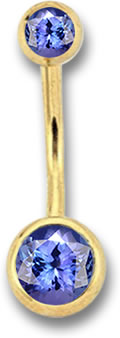Your Details
Your Details
|
Reviewed By Andreas Zabczyk
Extreme Body Jewelry from Past to Present Gold and Tanzanite Belly Ring
Body jewelry has been around for thousands of years, in fact, the oldest earrings found come from the Sumerian Tombs of Ur, which date from around 2300 BC. It is said that the long earlobes of Buddha images refer to the practice of wearing ear plugs of gradually increasing size that stretched and elongated the earlobes. This has become a more recent trend in the West, with flesh plugs being a more common sight on the street than a century ago. Some tribes, such as the Apatani women of Northeast India used to insert wooden flesh plugs into both sides of their noses and tattoo their faces. This is not so popular in contemporary Western body jewelry. Body piercing was practiced by the ancients, including the Egyptians and the Romans. Apparently, only the Pharaohs of ancient Egypt were permitted to have belly button piercings, but since the 1990s, this has become a popular form of mainstream body jewelry, with a wide variety of beautiful belly jewelry available (see, top image). It is said that Roman gladiators had their penises pierced to enable the penis to be tied to the testicles during fights, in order to avoid injury (the mind boggles!). These piercings also stopped gladiators from having sexual intercourse without their owners' permission, since their seed was considered valuable. Penis jewelry can also be seen in the illustrations of the Karma Sutra. Despite the Victorians' reputation for being repressed, there are records of Victorian women having nipple piercings. However, this was not a popular topic of conversation at the time. Modern interpretations of Genesis 24:22 and 24:47 suggests that nose piercings were practiced in ancient Biblical times. The Aztecs and Mayans wore nose piercings in the septum and the sides of the nose made of gold and gemstones such as jade. African, Australian and New Guinean tribes have also practiced nose piercing for hundreds of years.  Indian Pearl and Ruby Nose Ring
Nose rings have long been a part of Indian culture and are thought to have been introduced by the Mughals. Ancient Vedic texts mention nose rings. Nose rings worn by Indian women are often made from gold or silver and beautifully embellished with gemstones, such as rubies and pearls. They can be a symbol of status, religion or marriage. Some Indian wedding nose jewelry consists of a hoop with a chain that attaches to an earring. Other styles worn in India are septum piercings called "nathori", which can be seen on images of Hindu gods, such as Krishna, though these are not as widely worn. Indian nose rings can be so large that they cover part of the mouth. Nose rings came to the West during the 1960s, when hippies visited India. They were later adopted by punks in the 1970s and 80s. Nowadays, nose rings are a popular form of mainstream fashion jewelry. Other types of body modification have been practiced throughout history by various cultures, such as the filing of teeth into sharpened points by the Balinese and the wearing of gemstone dental implants by the Mayans. Lip piercing and the insertion of labrets (lip plates) has also been done for hundreds of years by Northwest Coast American Indians; some of the labrets would be made from gold and jade. This is still practiced by some tribes, such as the Mursi in Ethiopia and the Kayopo of Brazil. For some these lip plates used to be a marker of social status or a protective amulet. Lip plates generally begin as piercings, which are then stretched by the wearing of plugs of gradually increasing size. Modern variations on this theme are lip piercings that are not stretched, but house barbells or studs, sometimes with attractive colored gemstones. A few contemporary body modification enthusiasts in the West experiment with flesh plugs in the lips and even the cheeks.  Northern Thai Palong Silver Ear Plugs
The Padaung tribe of Mae Hong Son in Northern Thailand have taken the necklace to another level. Some of the Padaung ladies use brass rings to depress their collar bones and upper ribs, which gives their necks an elongated appearance. They are known as the "long-necked women" or "giraffe women". The neck rings are heavy, weighing around 4.5 kilograms. Unfortunately, the neck muscles are severely weakened, so the rings must be worn throughout the life. This practice has not caught on in the West, but chokers and other necklaces are widely worn with less permanent consequences. Other Karen tribes of Northern Thailand, such as some of the Palong people, favor silver jewelry, including silver ear plugs, which stretch their ear lobes. They also use gold to decorate their teeth. Both tribes also wear anklets, bracelets and leg rings.  Platinum Star Eye Gem Implant
Body modification has always existed, though some forms are more generally accepted in some societies than others. For example, in ancient China, it was the norm to practice foot binding, and in the West, a small waist was so attractive that some women had ribs removed and wore uncomfortable corsets to achieve this. What may seem normal to one culture may appear very strange to another. Having said this, anything that is unnatural could be considered strange by some. Body jewelry seems to grow more extreme in its quest to experiment, shock or to be different. The lengths people go to in order change their appearance now include tongue splitting, sub-dermal implants, gold-plated magnetic finger implants, branding (scarification), platinum eyeball jewelry (see, image above), corneal tattoos, sub- and micro-dermal implants, tooth tattoos and gold contact lenses. |
